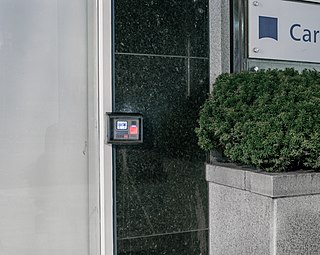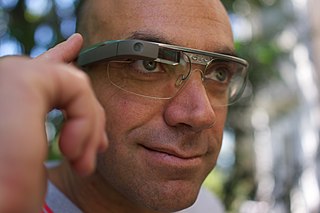
In physical security and information security, access control (AC) is the selective restriction of access to a place or other resource, while access management describes the process. The act of accessing may mean consuming, entering, or using. Permission to access a resource is called authorization.

In electronics, a remote control is an electronic device used to operate another device from a distance, usually wirelessly. In consumer electronics, a remote control can be used to operate devices such as a television set, DVD player or other home appliance. A remote control can allow operation of devices that are out of convenient reach for direct operation of controls. They function best when used from a short distance. This is primarily a convenience feature for the user. In some cases, remote controls allow a person to operate a device that they otherwise would not be able to reach, as when a garage door opener is triggered from outside.

AMX is an American manufacturer of video switching and control devices. It is currently owned by Samsung Electronics through Harman International Industries, and is part of the Harman Professional Division.
Insteon is a proprietary home automation (domotics) system that enables light switches, lights, thermostats, leak sensors, remote controls, motion sensors, and other electrically powered devices to interoperate through power lines, radio frequency (RF) communications, or both. It employed a dual-mesh networking topology in which all devices are peers and each device independently transmits, receives, confirm and repeats messages. Like other home automation systems, it had been associated with the Internet of things.

Z-Wave is a wireless communications protocol used primarily for residential and commercial building automation. It is a mesh network using low-energy radio waves to communicate from device to device, allowing for wireless control of smart home devices, such as smart lights, security systems, thermostats, sensors, smart door locks, and garage door openers. The Z-Wave brand and technology are owned by Silicon Labs. Over 300 companies involved in this technology are gathered within the Z-Wave Alliance.

Recon Instruments was a Canadian technology company that produced smartglasses and wearable displays marketed by the company as "heads-up displays" for sports. Recon's products delivered live activity metrics, GPS maps, and notifications directly to the user's eye. Recon's first heads-up display offering was released commercially in October 2010, roughly a year and a half before Google introduced Google Glass.
Lenovo smart televisions use the Android operating system and are marketed as the "LeTV" in Mainland China.
IFTTT is a private commercial company founded in 2011, that runs online digital automation platforms which it offers as a service. Their platforms provide a visual interface for making cross-platform if statements to its users, which, as of 2020, numbered 18 million people.

ecobee is a Canadian home automation company that makes smart thermostats, temperature and occupancy sensors, smart light switches, smart cameras, and contact sensors.

Burner is a mobile application for iOS and Android made by Ad Hoc Labs, Inc. that allows users to create temporary disposable phone numbers in the U.S. and Canada. The app allows smartphone users to have a phone number that is anonymous and can be thrown away, for purposes such as online ads, while traveling, for business projects, or for dating profiles. Burner is a product of Ad Hoc Labs, an Atwater Village, Los Angeles-based software startup.

LIFX is a line of energy-efficient, multi-color, Wi-Fi enabled, digital addressable LED light bulbs that can be controlled via a Wi-Fi equipped device such as a smartphone or smartwatch.

Smartglasses or smart glasses are eye or head-worn wearable computers that offer useful capabilities to the user. Many smartglasses include displays that add information alongside or to what the wearer sees. Alternatively, smartglasses are sometimes defined as glasses that are able to change their optical properties, such as smart sunglasses that are programmed to change tint by electronic means. Alternatively, smartglasses are sometimes defined as glasses that include headphone functionality.

HomeKit, also known as Apple Home, is a software framework and communication protocol developed by Apple Inc. that lets users configure, communicate with and control smart-home appliances using Apple devices. It provides users with a way to automatically discover such devices and configure them. By designing rooms, items and actions in HomeKit, users can enable automations in the home through a voice command to Siri or through the Home app. With HomeKit, developers are able to create complex applications in order to manage accessories at a high level.
Amazon Echo, often shortened to Echo, is an American brand of smart speakers developed by Amazon. Echo devices connect to the voice-controlled intelligent personal assistant service Alexa, which will respond when a user says "Alexa". Users may change this wake word to "Amazon", "Echo", "Computer", as well as some other options. The features of the device include voice interaction, music playback, making to-do lists, setting alarms, streaming podcasts, and playing audiobooks, in addition to providing weather, traffic and other real-time information. It can also control several smart devices, acting as a home automation hub.

Sensibo is a manufacturer of air conditioning controllers.
HomeSeer Technologies LLC is a technology company based in Bedford, New Hampshire, in the United States. HomeSeer makes home automation controllers and software, designed to integrate lighting, HVAC, security, AV and other subsystems in most homes. Additionally, the company maintains an online store of compatible home automation products and a free online community forum for users and dealers.
Myfox is a privately held French company that designs and produces connected, sensor-driven and wireless home security equipment.

Wink is an American brand of software and hardware products that connects with and controls smart home devices from a consolidated user interface. Wink, Labs Inc., which develops and markets Wink, was founded in 2014 as a spin-off from invention incubator Quirky. After Quirky went through bankruptcy proceedings, it sold Wink to Flex in 2015. As of 2016, the Wink software is connected to 1.3 million devices. In July 2017, Flex sold Wink to i.am+ for $59M.
Hive is a trademark owned by Centrica Hive Limited that produces smart home devices. It is one of the largest connected home providers in the UK and, as of May 2018, the company had more than 1,000,000 customers.

Flipper Zero is a portable Tamagotchi-like multi-functional device developed for interaction with access control systems. The device is able to read, copy, and emulate RFID and NFC tags, radio remotes, iButton, and digital access keys, along with a GPIO interface. It was first announced in August 2020 through the Kickstarter crowdfunding campaign, which raised $4.8 million. The first devices were delivered to backers 18 months after completion of the crowdfunding campaign. The device's user interface embodies a pixel-art dolphin virtual pet. The interaction with the virtual pet is the device's core game mechanic. The usage of the device's functions defines the appearance and emotions of the pet.













